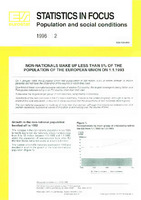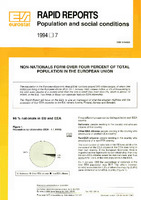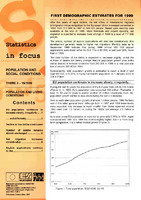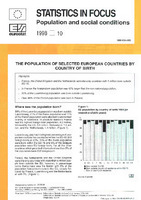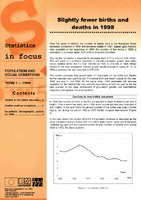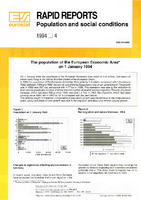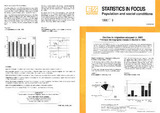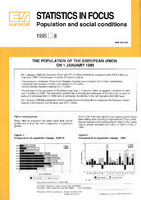Αναζήτηση
Αποτελέσματα 81-88 από 88
Statistics in Focus: Population and social conditions. NON-NATIONALS MAKE UP LESS THAN 5% OF THE POPULATION OF THE EUROPEAN UNION ON 1.1.1993. 1996.2
(Eurostat, 1996-02)
On 1 January 1993, the European Union had a population of 368 million, 4.8% of whom (almost 18 million persons) did not have the citizenship of the country in which they lived. One-third of these ...
RAPID REPORTS Population and social conditions. THE POPULATION OF THE EUROPEAN ECONOMIC AREA IN 1992. 1993.7
(Eurostat, 1994-07)
The population in the European Economic Area (EEA) numbers around 370 million people, of whom 344 million are living in the European Union (EU). On 1 January 1992, sixteen million or 4% oí those living in the EEA were ...
Statistics in Focus: Population and social conditions. FIRST DEMOGRAPHIC ESTIMATES FOR 1999.
(Eurostat, 1999)
After five years of rapid decline, the net inflow of international migrants (immigration minus emigration) to the European Union increased somewhat in 1998: from 512 000 in 1997 to 549 000 ...
Statistics in Focus: Population and social conditions. THE POPULATION OF SELECTED EUROPEAN COUNTRIES BY COUNTRY OF BIRTH.
(Eurostat, 1998-10)
Highlights . France, the United Kingdom and the Netherlands were the only countries with 1 million born outside EU-15. . In France the foreign-born population was 42% larger that the non-national population. . 30% of the ...
Statistics in Focus: Population and social conditions. Slightly fewer births and deaths in 1998.
(Eurostat, 1999-01)
After five years of decline, the number of babies born in the European Union increased somewhat in 1996 and remained stable in 1997. Based upon monthly data available at the beginning of 1999, ...
RAPID REPORTS Population and social conditions. The population of the European Economic Area* on 1 January 1994.
(Eurostat, 1994-04)
On 1 January 1994 the population of the European Economic Area stood at 375 million, 349 million of whom were living in the twelve Member States of the European Union. In 1993 the population of the European Economic Area ...
Statistics in Focus: Population and social conditions. Decline in migration stopped in 1995 Principal demographic trends in the EU in 1995.
(Eurostat, 1996-06)
During the period 1992-1994 the net inflow of international migrants to the European Union decreased drastically. After the 1992 peak of 1.3 million persons, net migration dropped to 1.0 million in 1993 and 0.8 ...
Statistics in Focus: Population and social conditions. THE POPULATION OF THE EUROPEAN UNION ON 1 JANUARY 1995.
(Eurostat, 1995-01)
On 1 January 1995 the European Union had 371.5 million inhabitants, compared with 348.6 million on 1 January 1994. This increase of nearly 23 million is due to: - the accession of Austria, Finland and Sweden (together ...

